It is said that the more aware you are of death the more you enjoy life, savoring consciously every drop of its juice before it ends. Seneca, the Roman philosopher, wrote that wonderful book (everyone should read), On the Shortness of Life. Life is Long if You Know How to Use It. Our greatest possessions, according to him, are ‘the world you see’ and ‘the human mind’, for ‘it’s the mind that creates our wealth’, with greed being ‘the most overmastering plague of the human race.’
In India death is very present and in western standards it’s considered a “poor” country. Yet when you are there it feels lively and joyful, despite its obvious hardships and contradictions. Ettore Sottsass – architect, designer, artist and considered one of the most influential and unconventional figures in XXth century design”[1] – travelled to India more than 25 times during his lifetime. As Barbara Radice, his wife and collaborator, wrote in her beautiful critical biography of him, ‘the journey to India, like the earlier one to America and perhaps more deeply, was to change his whole life.’ He found something profound there. There was the colour and lusciousness of its physical reality, but mostly it was a spirituality transpiring into the visual world through rituals and objects – something, in his own way, he would infuse to all his work. Not long after his first trip to India, he had a near-death experience. Sottsass was seriously ill and Roberto Olivetti – who saved his life – had him hospitalised in the Californian city of Palo Alto in 1961, where he stayed for a couple of years until he was fully recovered. Radice records, ‘in the long period of hospitalisation at Palo Alto, the memory came back of the peculiar calm and naturalness with which these people experience relations with disease and death. India does not avoid and is not obsessed by the decay or dilapidation caused by life and the passing of time.’
Sottsass, who passed away in 2007, knew how to enjoy life. A perennial learner, he was considered a wise man by everyone who had contact with him. Coinciding with the end of the exhibition Ettore Sottsass: Design Radical at the Metropolitan Museum, curated by Christian Larsen, three of his close collaborators in the US came from California to New York for a special celebratory discussion about their friend. They were David Kelley, founder of IDEO and of Stanford University’s Hasso Plattner Institute of Design, for whom Sottsass designed his private home in 2000; architect Johanna Grawunder, who worked with him on his post-Memphis architecture projects in the US; and artist and designer Peter Shire (see interview in DAMN° 62 and also online), who along with Sottsass, was part of the Memphis Design Group.
I don’t know if there is life after death (as Hindus believe), but we do keep living in the people who loved us, and in the case of Sottsass, in the magical world he created and left behind. It was a warm event filled with life and laughter, as it should be, so we decided to share it.
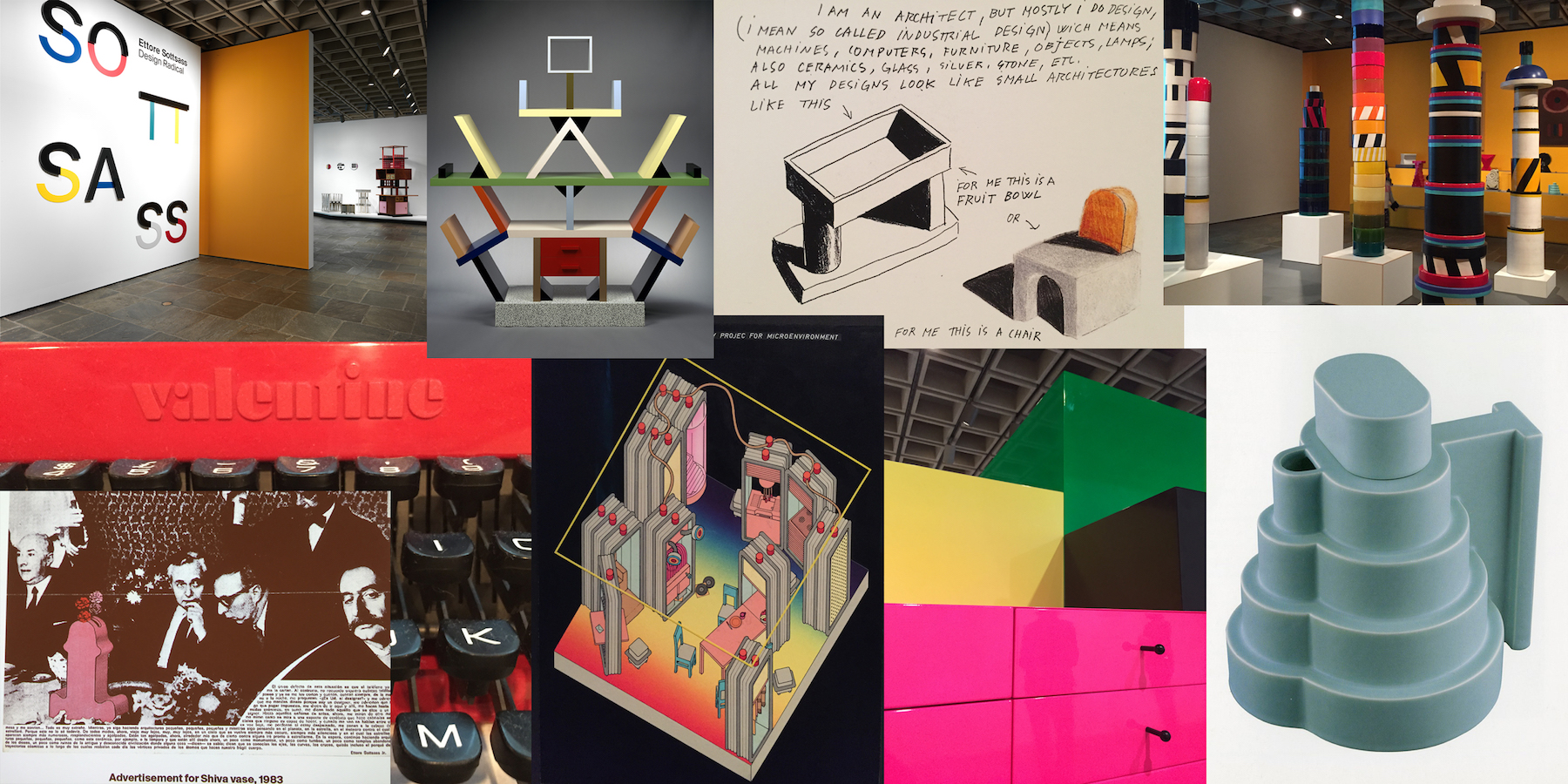
Christian Larsen: California seems to be very important to Sottsass; it had an impact on him. It is literally where he was brought physically back to life. He spent two years there rehabilitating from his illness, during that time he fell for the Beats. His first wife Fernanda Pivano introduced him to Hemingway, then to Jack Kerouac, Allen Ginsberg, Bob Dylan. So I wonder, given that relationship, did Sottsass ever talked to you about his time in California?
Peter Shire: This picture is perfect
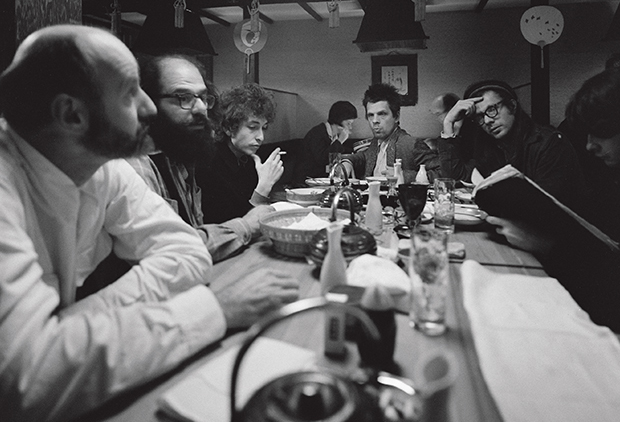
– Bob Dylan came in, and all these guys were there at the Chinese restaurant and they were completely overwhelmed by Dylan’s presence. I always thought that was part of the reason he named it Memphis – not so much because of the song [Stuck Inside of Mobile with the Memphis Blues Again], as they say – but I think he really wanted to co-opt that power.
David Kelley: Coming from Milan, Ettore really noticed the weather in California. He also talked to me a lot about his time at the hospital. I guess because I’ve been a Stanford professor for 30 years and he was at the Stanford hospital – room 128. There is a series of fantastic books he did there. Ettore did the illustrations and Lawrence Ferlinghetti the poetry. Despite his love/hate relationship with technology, he had a real fondness for Stanford and for Palo Alto – maybe because his life was saved there. When we were designing the house, he was so effusive about how much he enjoyed being back. One of the reasons was because people let their ideas fly more easily there – and that was him. He felt totally at home; stating his opinion and arguing with everybody he could. You know, we were all wrong and he was right! (laughs)
Johanna Grawunder: (My story) is a little different. I truly felt that he recognised before most Californians that there are actually two Californias – the northern and the southern California – and my experience with him is the southern one. We had a couple of projects in LA, so we were there a lot. What I got from him was seeing California through an Italian’s eyes. And not just any Italian, but a very sensorially in tune Italian. We were driving around in a convertible through the freeways and all that sun – for me it was this joyous view he had of California. One of his best friends was there too, Mike Spolsky, so that help to keep bringing him back.
CL: Before he got to California though, he was in India, and I think that is another place where he really had a life-changing experience. There he found something very different from what he would experience in the States. His first time in the US was in 1956, with Fernanda Pivano. She was here in order to interview American writers, Hemingway above all, but many others included, and Sottsass, the newly-wed said, ‘Ok, I guess I am coming with you.’ He met George Nelson the year before, so he went on to work in Nelson’s office for three months. It seems weird – I can’t see those two personalities together – but they really loved each other, for the rest of their lives they spoke fondly of one another. When he is in New York, for those three months with Nelson, he is totally impressed by the United States of the 1950s. The US was in an economic boom, we were building cookie-cutter houses in the suburbs, we were mass producing cars… This sort of technological advanced civilisation couldn’t have been more different from war-torn Italy or India. The flip side to all this mass production was that there was mass consumption of all the same things, which was leading to a culture of sameness. In India he found the flip side to that – a kind of poverty of objects, but the objects they had were loved. There was almost a spiritual connection to them. It’s in India where he comes up with these totems – which I think when he is on his deathbed in Palo Alto, you see these totems of liquids and pills he has to take every day to bring him back to health. He is thinking of the totem as a thing that means something spiritual, as a human marker. And then in 1967 he realises this exhibition [Menhir, Ziggurat, Stupas, Hydrants, and Gas Pumps (1965–66), displayed at the Galleria Sperone] of all of the ceramic totems, and for me, this project sort of summarises that shift in his thinking. From being trained towards mass production he went into objects that had a different kind of meaning, that were injected with soul and emotion, with other functions beyond the pragmatic and more physical. And I was wondering what you thought about this aspect of his career – the place of India and how it shaped his kind of thinking? He continued to go to India throughout his life. Did he speak about India to you?
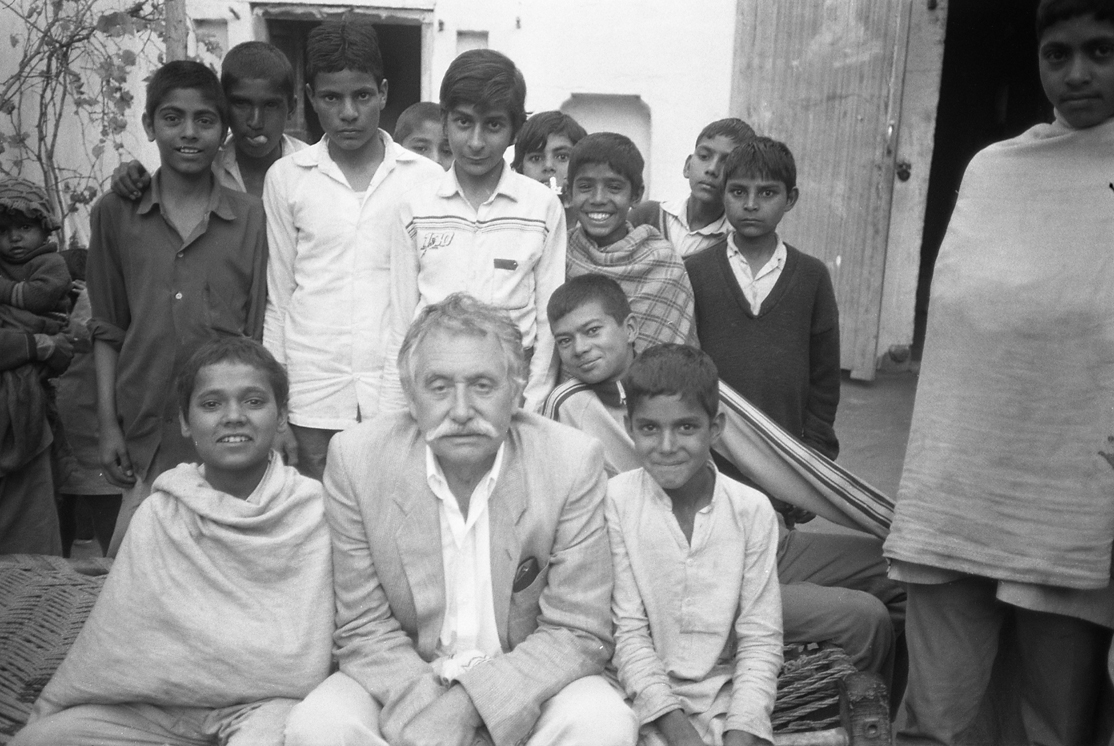
JG: Yes, he spoke constantly about India. The main thing I understood he took from it, was this kind of poetic softness of everything. But also the tragedy you see everywhere. It’s very much like seeing the best and worst of humanity. A couple of times we went with specific projects in mind. One of them was photographing Hampi, which as an architecture student from the West, I didn’t know what it was. I guess we knew all about the Acropolis, but in the middle of India there’s this amazing ruined city, quite intact, and people are making their own lives within these temples, sort of squatting in there. Ettore went there to photograph it, and what was really interesting was to see how deep into the level of detail he would go. He was almost looking at the architecture as if they were objects. He would zoom into a tiny little carving, or zoom into a tiny little column articulation, and this was pure curiosity to see what was going on. Also totally courageous, no fear of going into someone’s house and, you know, taking a picture, and it ended up in everybody hugging – very generous as well. He would eat everything that they offered him!
PS: Never got sick?
JG: Never got sick.

PS: When Ettore came to LA for his last show, he spoke at the Getty and the curator was asking him about his time at George Nelson and America. He said the thing that struck him about America at that time, was that nobody talked about death. And in Italy, everybody constantly talked about death.
DK: The totems are so important to Ettore, and throughout his work – especially in the show in 1972 at MoMA Christian was talking about [Italy: The New Domestic Landscape]. This was like science fiction predicting the future, and it’s held true all these years. So he continued to use those totems and boxes. Even my house that was built in 2000 is full of them. In the middle of nowhere you have these boxes! And it’s what most people react to, saying: ‘When are you going to move these to where they are supposed to be?’ But they are bolted to he floor! With lights and all.
Many times, Ettore would say something that kind of resonated with me but I wasn’t sure it was true, but it always turned out to be true. He was so wise…You had the feeling that you were in the presence of greatness. I know it might sound dramatic, but this is how I felt. When you were with him, especially alone, on a train coming back from Venice or somewhere, it was just something about him. So he would say to me I would complain about having all these random boxes in the middle of the house taking all this space. For him, it was always human centric, everything he said would come through with respect on how people really would relate to things – the height of something or how wide it was or a colour – it wasn’t like he was an artist exclusively, saying here is my idea and you should like it. He understood how people react, so with me when I complained about these boxes in the middle of nowhere he’d say: ‘Look, they are human scale, the boxes are about the size of a human – about the height, about the width – and he said, this will make people more comfortable in your house, they will stand next to one of these boxes like it was their friend.’

CL: I wanted to get David’s read on some drawings that Ettore did in 2000 where he predicts fake news. It is called Electronic instruments for the production of the ego. He says: ‘During the next millennium democracy will reach the maximum point of freedom, everybody will be able to do whatever they want, the fundamental and only production will be the production of the ego, therefore a system of little boxes will be made, which are only approved by marketing to be in black or AT&T white. These boxes are for the production for self-made planetarian news, as one likes them. It could even produce seasons as you want them.’
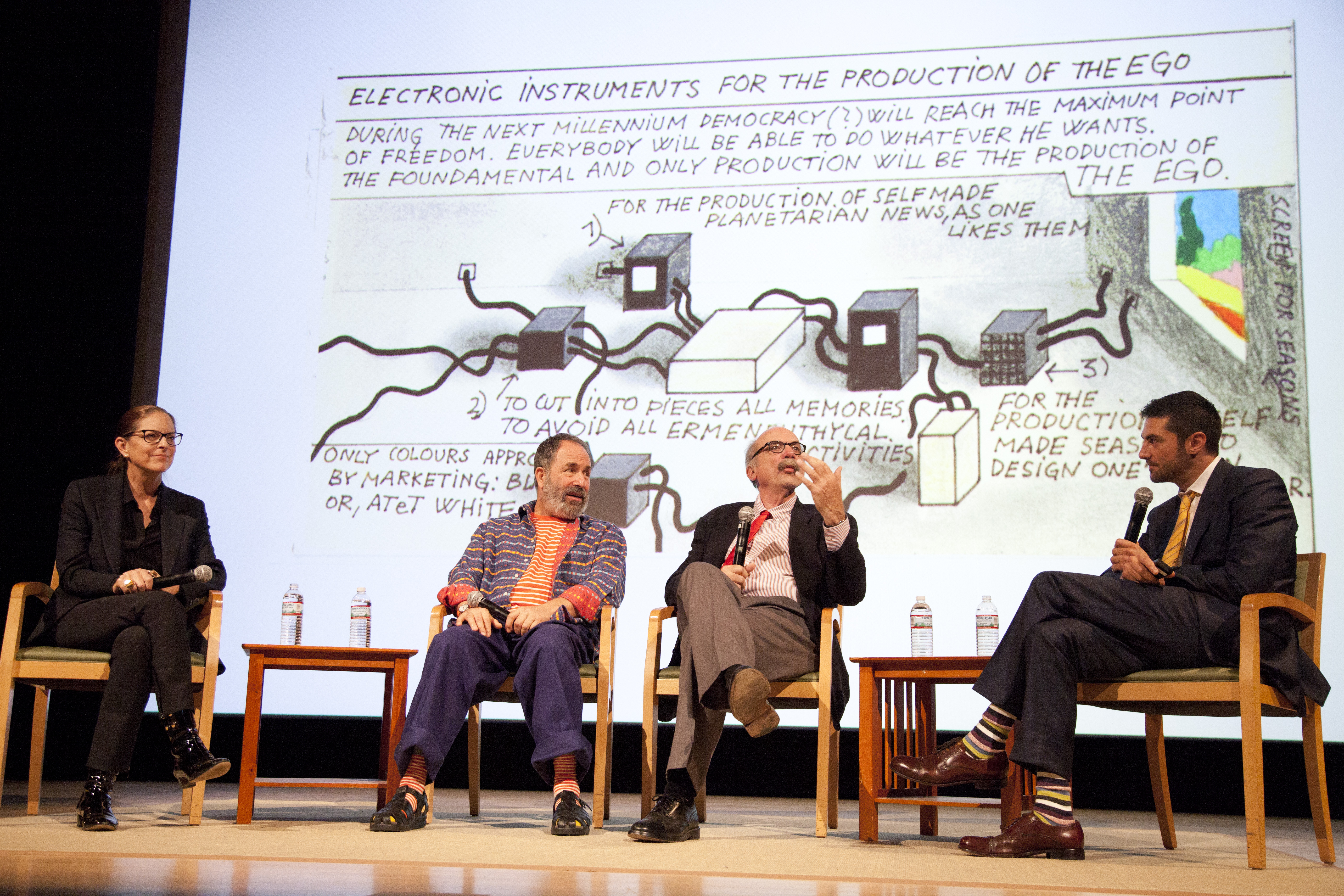
DK: Ettore is making fun of us in this drawing. As I said before, he has a funny relationship with technology, which is fascinating. He has what is called a broad mindset – his mindset is so open to what’s next and to learn. He’s a life-long learner in that way. He kind of liked the idea that technology was predicting the future but it was so inhuman, compared to his life – you know lunch was a lot more important than the iPhone. Here I think he is poking fun, and he trying to show that there is – even with these little black boxes with the lines – there’s still an exciting visceral human future out there. It’s the internet of things where you are not talking about the technology, but you are talking about the human aspects that might be empowered by this. So I think he liked technology, and I think he could dream of a world that was quite different from the present world, which he liked to talk a lot about – his visionariness. The technology thing was just a possibility that could fuel his view of the future of all things human – religion, politics…You know, you didn’t sit with him very long before there was a discussion about politics and everybody is yelling at everybody else. It’s funny, Italians are a little different to me at least, and Americans. They fight so much. I mean, I just thought they hated each other, and the next morning they are all having breakfast like friends.
PS: The next minute! (laughs)
CL: Peter this was your favourite Sottsass object.
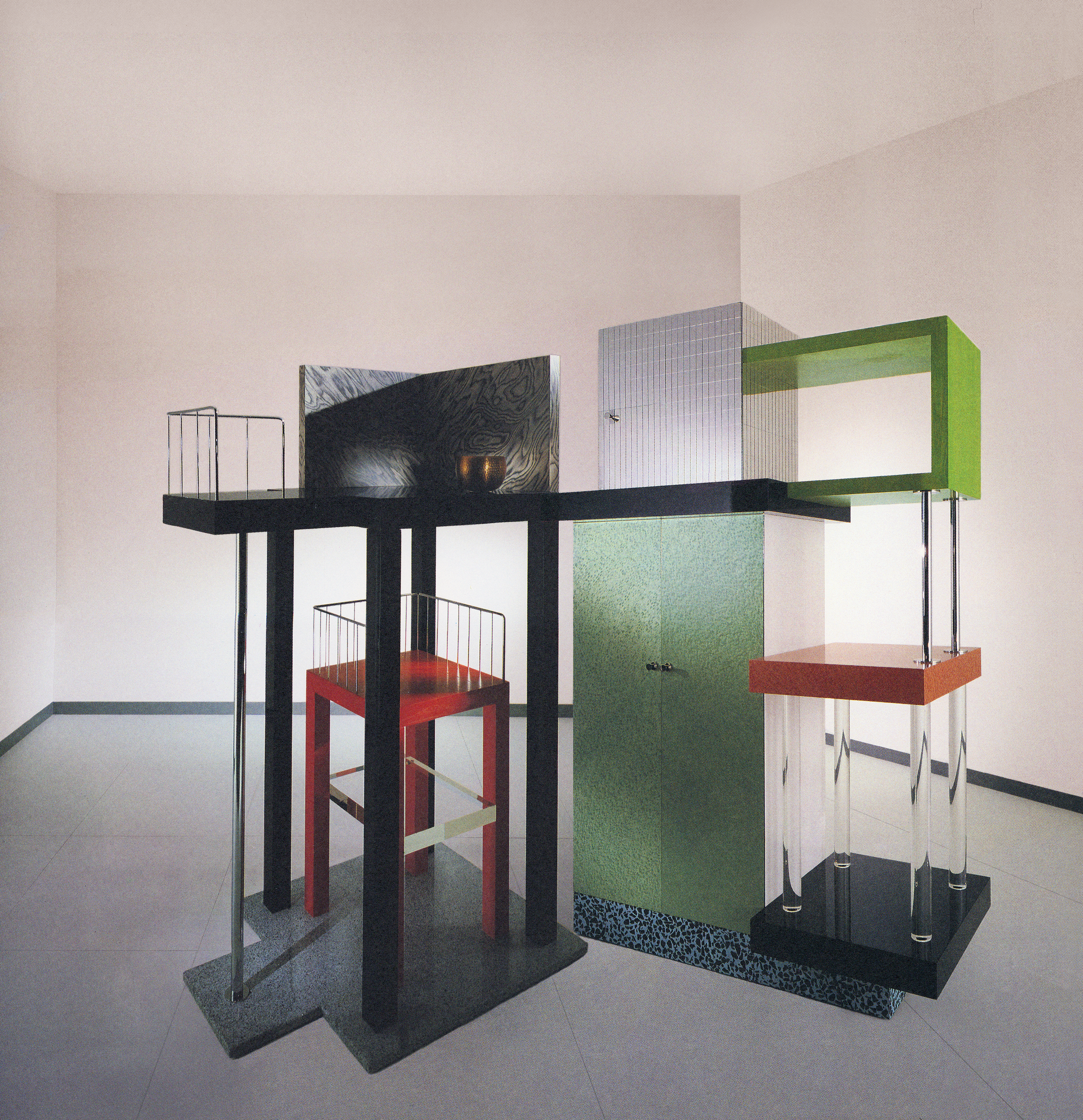
PS: Oh, yeah. This was our own test. It’s actually two of them together, because I can never decide which one of them I like more. And I was thinking about them – I saw these things in my memory – so I went back to the exhibition catalogue and I couldn’t find it! Then I realised that I had put them together in my mind. So on the computer we just put the two of them together and sent them to Christian to see if he would notice. And part of the reason they are favourites of mine is because this came right at the end of the Memphis experiment. It seemed to be a refined synthesis, using materials that he could use, and ones that he couldn’t quite use. It has a fineness that the other pieces don’t, it veers away from the pop commercial aspect of Memphis and it really shows what he is doing.
CL: Johanna you sent me a couple of things as your favourites, and this being one of them, the Tartar Console.
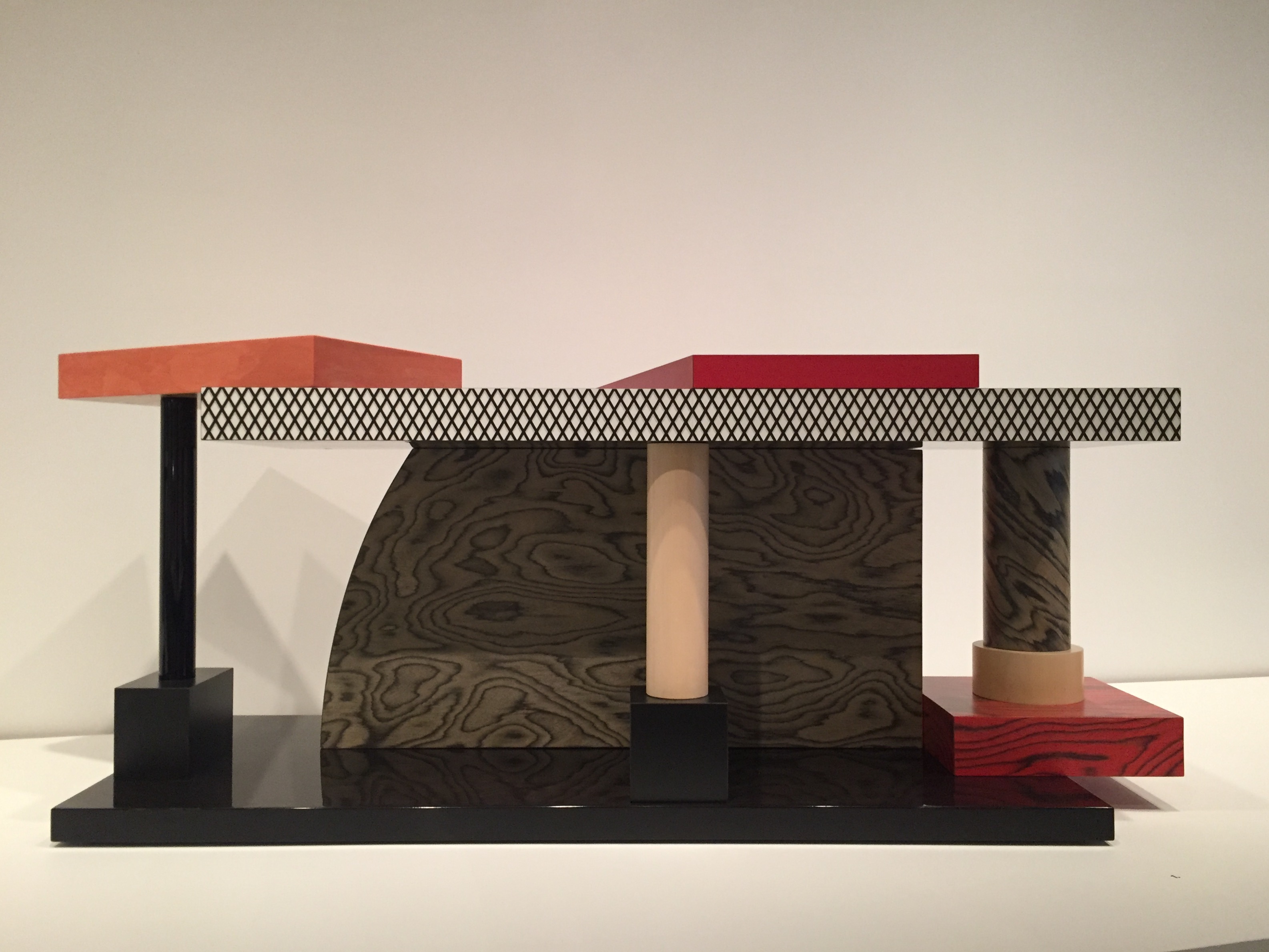
JG: So Peter likes the Blum Helman [NY art gallery which did a show on Sottsass’ furniture in 1987 called Furniture for the Ritual of Life] pieces, which I think are right after the Memphis. For me, this piece [the Turtle Console] is the last thrall of Memphis. I think it’s in the last collection, and suddenly you see nothing is symmetrical anymore. It starts to look very architectural and very much like the architecture that then happened over the course of the next years. I think it is a functional object, David even has it in his house I don’t know if you use it or not – do you use it?
DK: Yeah! I do.
JG: So I like that he is taking the scale. You could put little cars in there and it could seem like a building. For me, this was his final Memphis.
CL: I also wanted to mention that you’ve said the Wolf House was your favourite. Is this the first project that worked on with Ettore?
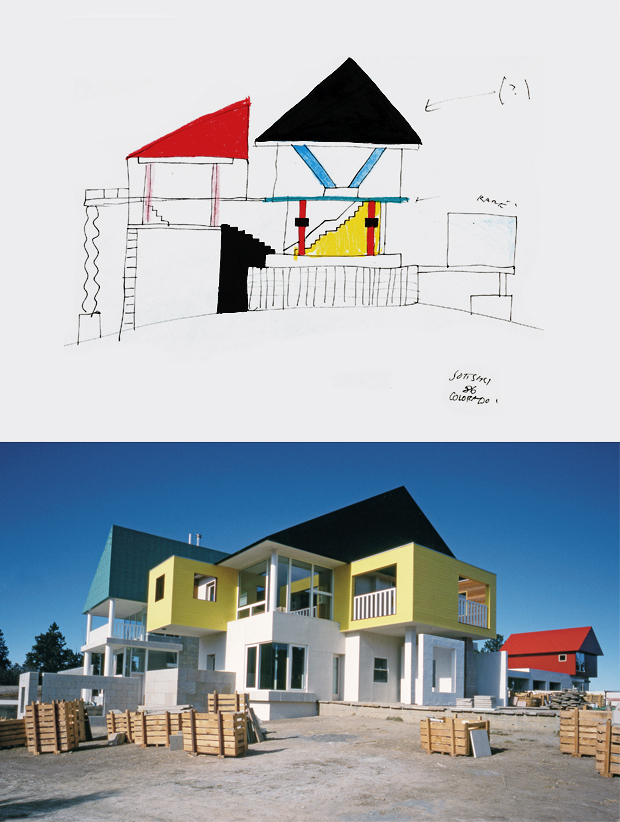
JG: Yes, this is the big one for me because…We did a lot of projects together, a lot of houses as well, so you shouldn’t really pick a favourite – it’s like picking a favourite child. But I am going for the first born, which was actually the Wolf House. At that point we had worked for few years on these ESPRIT showrooms, so it was already a 3D, larger scale interpretation of what Memphis was doing, and what Ettore’s full career was. By that time, he had this commission from Daniel Wolf to design an entire house from the ground up, which was the first one he had done I think in 45 years. He was bringing all to the table. He was trying to bring it from Memphis, but at the same time developing an entire new language that eventually ended up becoming the language of the architecture for the next 15 years that he worked on, I think. You have no idea of the amount of human energy that went into this house. We designed every single detail. Every single piece of furniture, everything is custom; everything was made in Italy and sent over, which is incredible. Since everything was pre-made, six little Italian workmen wearing slippers (unlike their American counterparts in work-wear boots), had to come live on site for six weeks – making pasta for lunch everyday – to install all this furniture that we had designed. Everything was extremely detailed. What you see in the sketches is in reality very similar to the very first sketches.
DK: I have to say that my house was done in a similar way, where the stuff that was shipped was designed and built in Italy. The same workmen who came to do Daniel’s house came to mine. They showed up with these big suitcases – like a tin with these wide stripes from the 50s. So I said, why do you have so many suitcases? ‘Pasta,’ they replied. They brought their own pasta.
JG: I know! And olive oil.
DK: And olive oil! Because you can’t get it in the US. I took them to North Beach, the Italian part, and they eventually agreed that we did have most everything. But they had a list of things we didn’t have they had to bring with them when they went to a job.
CL: This is the next drawing in the Wolf House drawings.
JG: Do you know the timing of these drawings?
CL: This one is 1986, but the three we saw before were earlier. It evolved past this for sure. And this is the final executed version of the house. And your name is on this drawing actually. You signed your name to it as well.
JG: Yeah. Because I did it. (laughs)
DK: Soon after that, that red thing exploded!

JG: There was a gas leak and apparently it actually popped off intact. (more laughter)
CL: So speaking of the Wolf House, I thought we’d show some of your house, David.
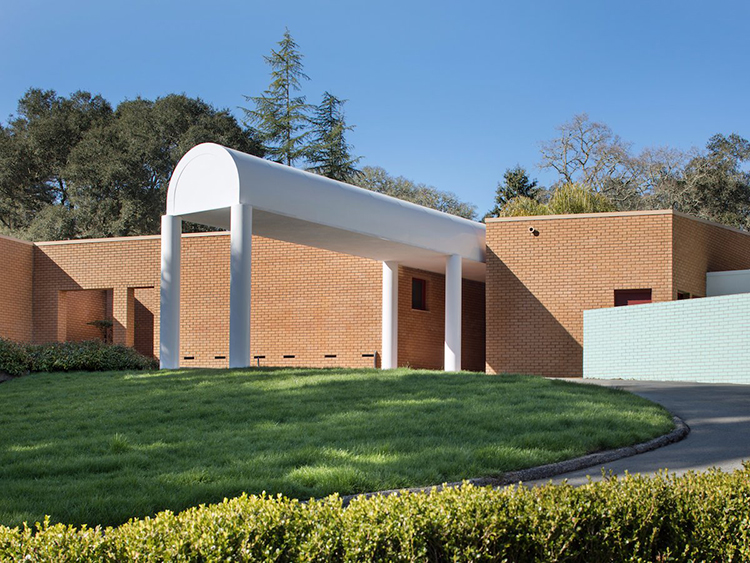
DK: As I said before, my house is much quieter then Daniel’s. Was my house the last he did? I think it was the last. Anyway, it’s quieter. I think that was as much because of me as it was about Ettore. I’ll tell one story: Ettore really didn’t like that American houses were – especially in this part of the country – to kind of show off your wealth. The house said, ‘Look at me.’ He wanted a house to say, ‘This is a private house, but you are welcome.’
I was friends with the painter Robert Williams, and Robert would ride by all the time and come up to the house. He’d always joke – imitating Ettore whom he knew because we used to travel together – about how his inspiration for my house was a freeway wall.
Anyway, the house is very plain from the front. Ettore also said, ‘Americans are so stupid; they feature the garage. I can’t stop noticing that when I drive around, systematically, the front of every house is a two-car garage presented to you like it’s the most important part of the house.’ There were lots of things Ettore did that were different. I’ll say this quick, but he really understood the inside-outside. This house is a bunch of six different pavilions, and each room has its own associated terrace, so there is an inside room and an outside room, and they are all tied together by this glass atrium – like a little village. And his point was different emotions – why should it all be the same? Each room and each building is made out a completely different material, some are shingle, some are stucco, bronze…I mean, he is just trying to show that there are lots of emotions. The contractor constantly tried to figure out how to take the drawings, extend the lines out and find some rationale, some vanishing point that made the whole thing rational. Ettore had been really pissed off at him because of it.

CL: And then from your house to Peter’s house.
PS: Much different production.
CL: Yes, your own design not Ettore’s design.

PS: That too, but basically this is a house that was remodelled in about 1984. I was working at the LA Olympics at that time, so the lamps got in there. And the thing about this house, is that it’s the most lacklustre supposed-stucco bungalow.
CL: A LA 1930s bungalow.
PS: Oh! Yeah. It was great. The record shows that it cost $3,700 to build it in the late 1930s. So my approach is completely different. There’s no architectural modification of the building or structure, just stuff added on. The only thing that was really changed was that corner – we put in a sort of communicating window, because Michele [De Lucchi] walked in and said, ‘Oh! You should put a window here.’ And then I told Marco (Zanini) and he said: ‘Yes, he puts a window everywhere.’ So this I think became very popular, because it looked like you could do it yourself. All you needed to do is change the accessories.
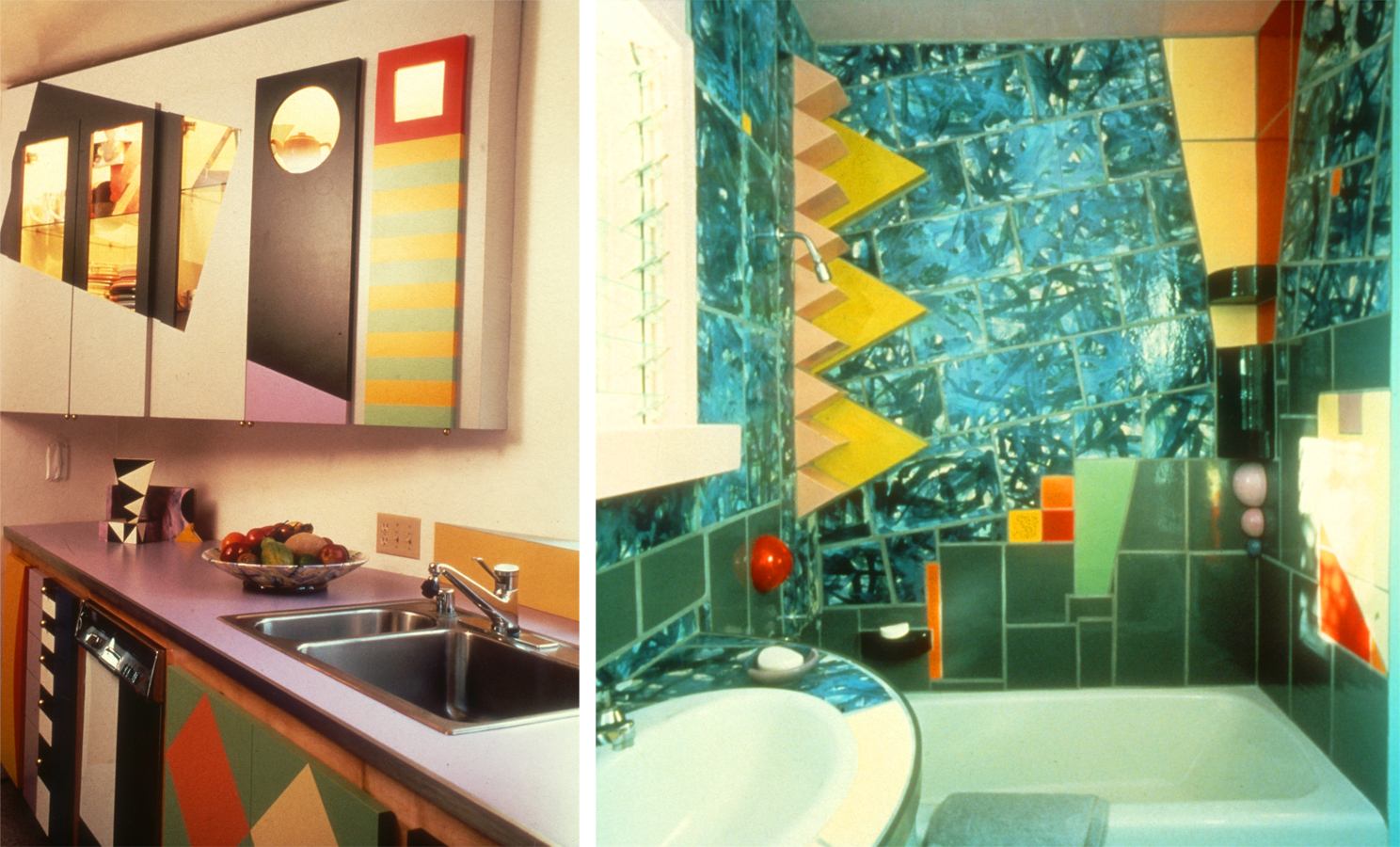
CL: I really like your idea of Mexican Bauhaus.
PS: Well, there are two reasons for that – maybe more. One is: you know Bauhaus was very rational, functionally oriented, and had a very high-minded idea of bringing design to people to, in a way, improve their lives – because of honesty of materials and form. We were sort of fighting – you know I love Bauhaus – and of course, you only fight something that you adore. So when I was going to Mexico, I was shocked by how many international style buildings were there. Wait a minute; it’s not just stucco or adobe – this sort of Alamo. So we got involved with this guy, who was my helper’s cousin, and he was really wacky and took us to Coyoacán. He didn’t know anything about Frida [Kahlo] and Diego [Rivera], but there we were, and that stuff was all modern, done by Juan O’Gorman. You know, Mexican Bauhaus.
CL: Your pieces reflect a lot of Bauhaus but with a twist. And as I was looking at some of your metal work, I could see where you had sewn pieces together or where you left the articulations rough. You could see that handmadeness of the object, and it made me think a lot of Bauhaus. And it reminded me that Bauhaus aspired to industrial production, they wanted to mass produce these things but they started at the same place where you start – craft, handmade. You have to create the prototype somewhere.
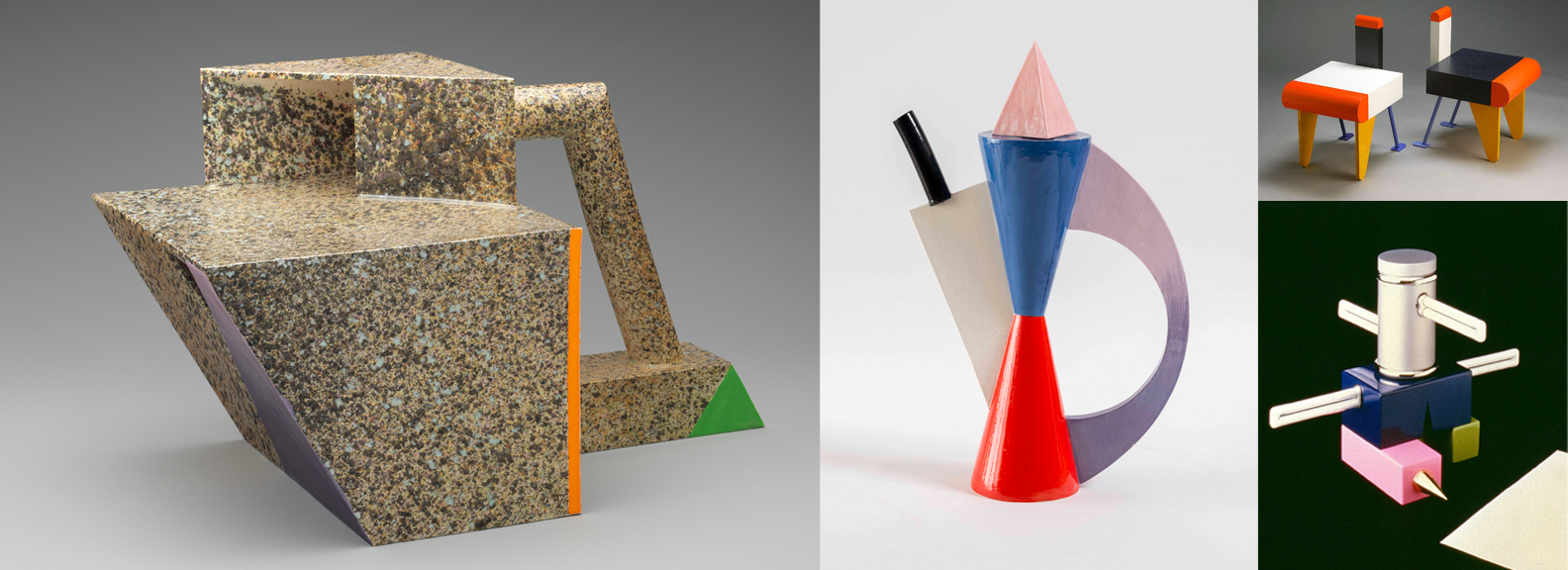
PS: We got into arguments with George Sowden about that, he took that kind of line that we were doing this for the populous. George is a real working-class hero. No, come on – I would say – we are making these things five at a time! But some of the things found their way…
CL: Yes, sometimes the seed of the idea that has been handmade and it’s expensive to produce, does actually find its resolution in mass production, but to do that it takes a lot of work and it’s not easy.
PS: It takes people being able to see it and want it; maybe getting use to it.
CL: Did you know Ettore when you were doing all this work before Memphis?
PS: I didn’t know any of the names. I had seen Domus in the school library, but I couldn’t read anything!
CL: I love that you have this picture of Alchimia [the design studio founded in Milan in 1976].
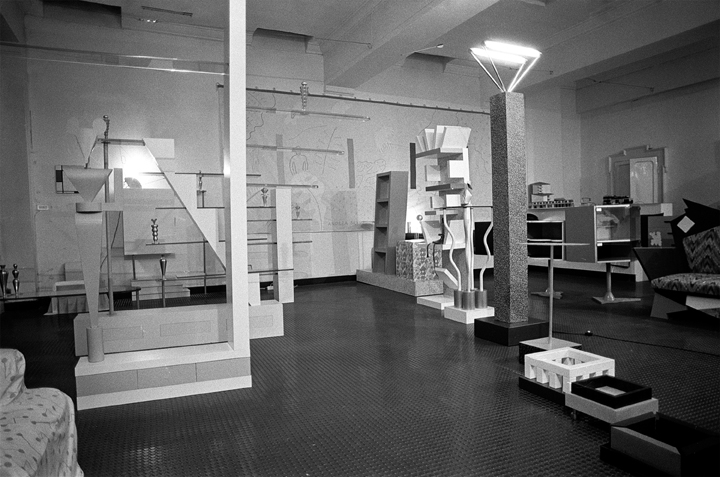
PS: Yeah, that one was the treasure. That’s the basement – Alchimia was in the basement. That was an experience, because that was in 1980.
CL: When Sottsass had left Alchimia, because of a difference in opinions?
PS: Right after that.
CL: Because of a difference in opinion with (Alessandro) Mendini, right? Mendini was sort of into one-off production, and Sottsass believed in unlimited productions?
PS: I can only say what I heard him saying. And he only said that Mendini was macabre.
JG: There’s a problem here. There was a Memphis collection that apparently you all thought was going to be mass-produced but, you know, there wasn’t a million people that wanted that stuff in the 1980s. I think there was more of a problem than just how to produce it at the right press point; it was also a problem of maybe six people in the world wanting it.
PS: And they are all here today! (laughs)
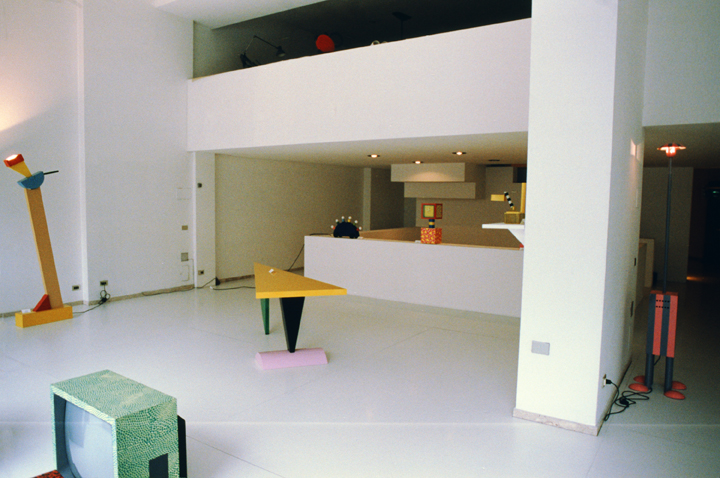
DK: It’s all misguided. I mean, by the time I got there in 1982, there still wasn’t a single person in the business that had seen any of these works.
PS: And talking about Mendini, it might have also been an Italian translation. To me, dealing over the last 30+ years with Italians, I am always realising that I don’t have a clue about what’s happening, and I am constantly finding out – I mean you speak Italian…
JG: Yes, but I am not going to trash talk Mendini.
PS: No! It’s not a question of trash talk. I think what they meant was his philosophy was different. , He believed that everything came from, or was a rehash of, something, and Ettore was always very interested in the new.
DK: I wish I knew what was going on at that lunch. I don’t know how many hours I sat for lunch, and Castiglioni and Mendini and Magistretti, all these famous people that I learnt about in school were there all talking, and I couldn’t understand a thing they were saying!
JG: It was probably politics.
DK: Yes. I have to tell this story. Ettore’s favourite restaurant for lunch was Torre di Pisa – it was always at Torre di Pisa – and if you hang with someone like Ettore, who is sensitive to this, the food was spectacular. So all these luminaries were having lunch and I couldn’t understand what was going on, but I was gushing about how good the food was, and Ettore kind of got tired of me gushing, so he said to me ‘What would you normally have for lunch?’ And I couldn’t tell him that I would wolf something down on my desk or in the car on the way to the next meeting, because, you know, he started worrying about lunch at about 10:30am – and it’s two hours long… So I said, ‘Well, I would have a tuna melt,’ you know, escalating my habitual lunch to a tuna melt. So he said, ‘What’s a tuna melt? (laughs.) So I said, ‘Well you have a can of tuna…’ – he looked at me with such disgust, and said ‘fish in a can?’ Anyway, then I said ‘Then you take a piece of cheese and put it on top of the fish’ (huge laughter from the audience). Even more disgusted, he said ‘cheese on fish?’ (laughs are not stopping at this point).
Anyway, in the days when I was building my house – it was done by faxes, this was before the internet – his pet name for me, after that day was ‘Tuna Melt’ (laughs again). So I have all these original faxes, and they all start out ‘Dear Tuna Melt’ (more laughs), and then he would say a bunch of shit about the house and they would always signed the same way ‘super love Ettore.’
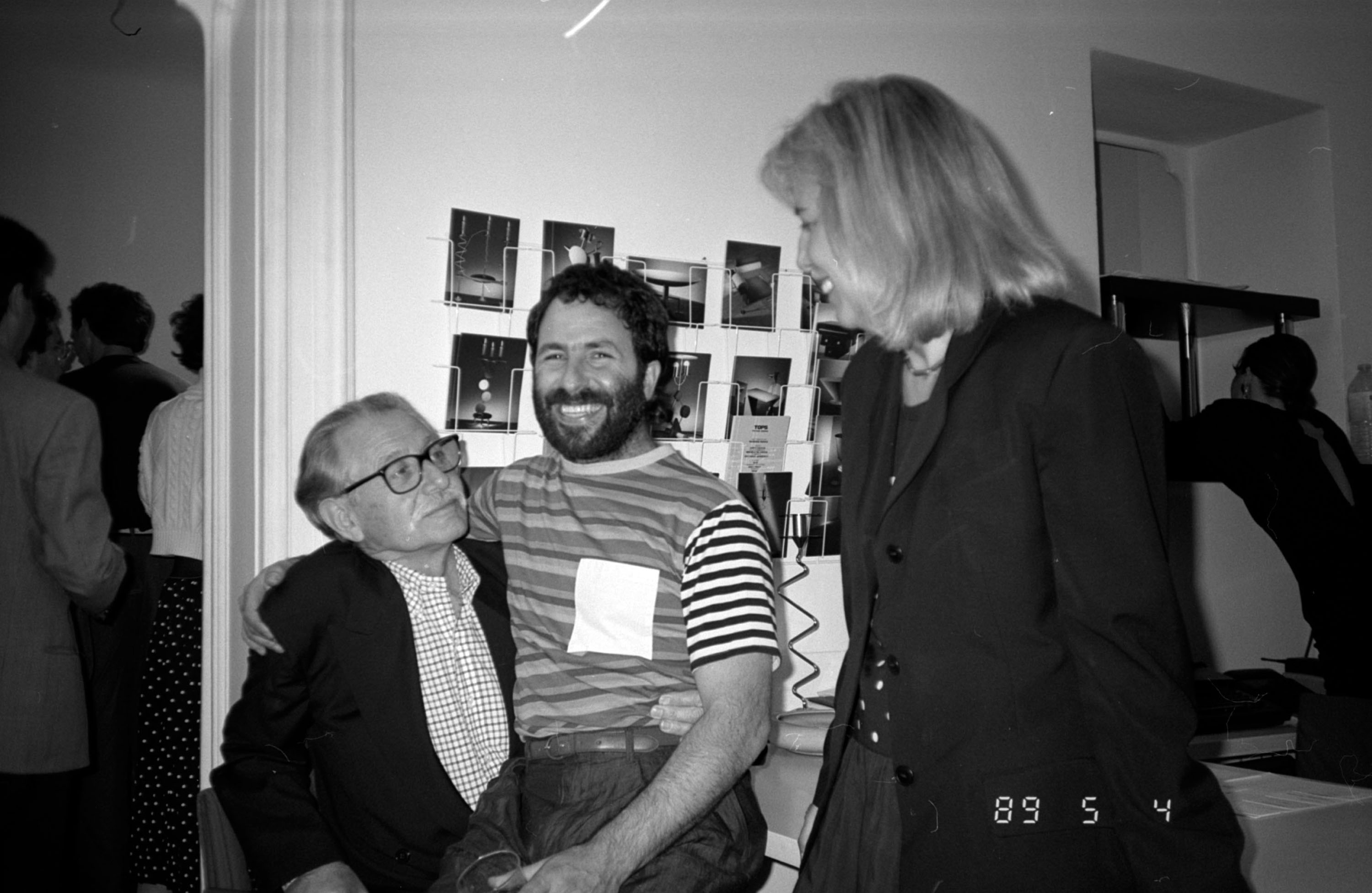
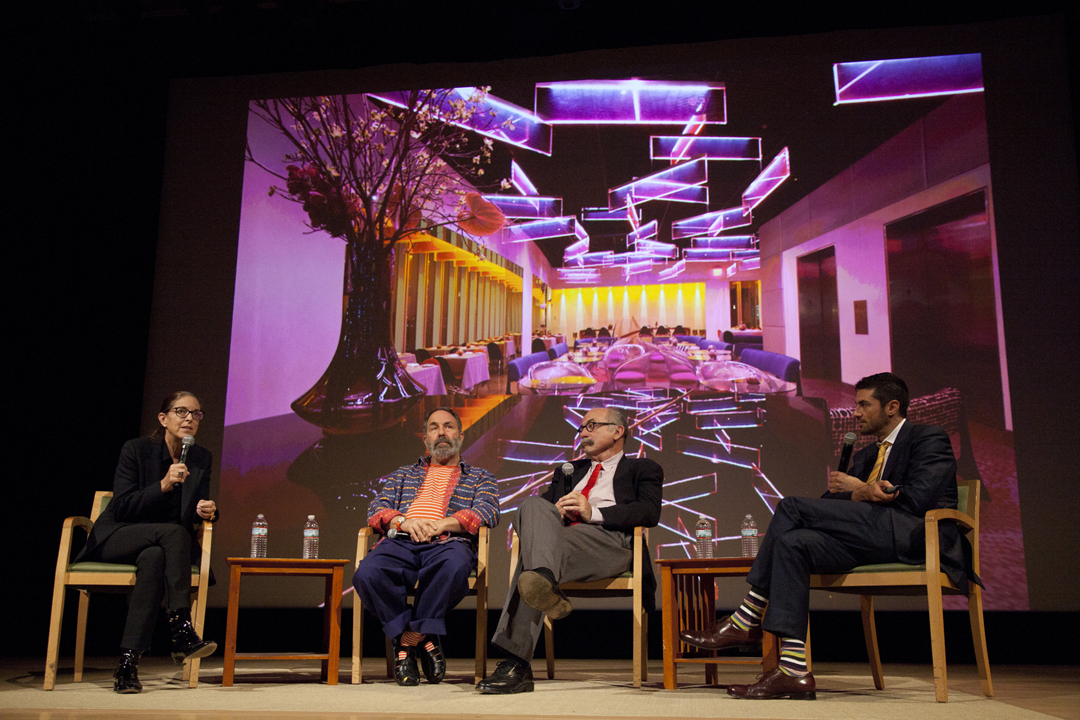
[1] Domusweb.it “Sottsass, rebel and poet” 10 July 2017
In India death is very present and in western standards it’s considered a “poor” country. Yet when you are there it feels lively and joyful, despite its obvious hardships and contradictions. Ettore Sottsass – architect, designer, artist and considered one of the most influential and unconventional figures in XXth century design”[1] – travelled to India more than 25 times during his lifetime. As Barbara Radice, his wife and collaborator, wrote in her beautiful critical biography of him, ‘the journey to India, like the earlier one to America and perhaps more deeply, was to change his whole life.’ He found something profound there. There was the colour and lusciousness of its physical reality, but mostly it was a spirituality transpiring into the visual world through rituals and objects – something, in his own way, he would infuse to all his work. Not long after his first trip to India, he had a near-death experience. Sottsass was seriously ill and Roberto Olivetti – who saved his life – had him hospitalised in the Californian city of Palo Alto in 1961, where he stayed for a couple of years until he was fully recovered. Radice records, ‘in the long period of hospitalisation at Palo Alto, the memory came back of the peculiar calm and naturalness with which these people experience relations with disease and death. India does not avoid and is not obsessed by the decay or dilapidation caused by life and the passing of time.’
Sottsass, who passed away in 2007, knew how to enjoy life. A perennial learner, he was considered a wise man by everyone who had contact with him. Coinciding with the end of the exhibition Ettore Sottsass: Design Radical at the Metropolitan Museum, curated by Christian Larsen, three of his close collaborators in the US came from California to New York for a special celebratory discussion about their friend. They were David Kelley, founder of IDEO and of Stanford University’s Hasso Plattner Institute of Design, for whom Sottsass designed his private home in 2000; architect Johanna Grawunder, who worked with him on his post-Memphis architecture projects in the US; and artist and designer Peter Shire (see interview in DAMN° 62 and also online), who along with Sottsass, was part of the Memphis Design Group.
I don’t know if there is life after death (as Hindus believe), but we do keep living in the people who loved us, and in the case of Sottsass, in the magical world he created and left behind. It was a warm event filled with life and laughter, as it should be, so we decided to share it.

Peter Shire: This picture is perfect

(left to right) Lawrence Ferlinghetti, Allen Ginsberg, Bob Dylan and Peter and Julian Orlofsky photographed by Ettore Sottsass, San Francisco, USA 1965
– Bob Dylan came in, and all these guys were there at the Chinese restaurant and they were completely overwhelmed by Dylan’s presence. I always thought that was part of the reason he named it Memphis – not so much because of the song [Stuck Inside of Mobile with the Memphis Blues Again], as they say – but I think he really wanted to co-opt that power.
David Kelley: Coming from Milan, Ettore really noticed the weather in California. He also talked to me a lot about his time at the hospital. I guess because I’ve been a Stanford professor for 30 years and he was at the Stanford hospital – room 128. There is a series of fantastic books he did there. Ettore did the illustrations and Lawrence Ferlinghetti the poetry. Despite his love/hate relationship with technology, he had a real fondness for Stanford and for Palo Alto – maybe because his life was saved there. When we were designing the house, he was so effusive about how much he enjoyed being back. One of the reasons was because people let their ideas fly more easily there – and that was him. He felt totally at home; stating his opinion and arguing with everybody he could. You know, we were all wrong and he was right! (laughs)
Johanna Grawunder: (My story) is a little different. I truly felt that he recognised before most Californians that there are actually two Californias – the northern and the southern California – and my experience with him is the southern one. We had a couple of projects in LA, so we were there a lot. What I got from him was seeing California through an Italian’s eyes. And not just any Italian, but a very sensorially in tune Italian. We were driving around in a convertible through the freeways and all that sun – for me it was this joyous view he had of California. One of his best friends was there too, Mike Spolsky, so that help to keep bringing him back.
CL: Before he got to California though, he was in India, and I think that is another place where he really had a life-changing experience. There he found something very different from what he would experience in the States. His first time in the US was in 1956, with Fernanda Pivano. She was here in order to interview American writers, Hemingway above all, but many others included, and Sottsass, the newly-wed said, ‘Ok, I guess I am coming with you.’ He met George Nelson the year before, so he went on to work in Nelson’s office for three months. It seems weird – I can’t see those two personalities together – but they really loved each other, for the rest of their lives they spoke fondly of one another. When he is in New York, for those three months with Nelson, he is totally impressed by the United States of the 1950s. The US was in an economic boom, we were building cookie-cutter houses in the suburbs, we were mass producing cars… This sort of technological advanced civilisation couldn’t have been more different from war-torn Italy or India. The flip side to all this mass production was that there was mass consumption of all the same things, which was leading to a culture of sameness. In India he found the flip side to that – a kind of poverty of objects, but the objects they had were loved. There was almost a spiritual connection to them. It’s in India where he comes up with these totems – which I think when he is on his deathbed in Palo Alto, you see these totems of liquids and pills he has to take every day to bring him back to health. He is thinking of the totem as a thing that means something spiritual, as a human marker. And then in 1967 he realises this exhibition [Menhir, Ziggurat, Stupas, Hydrants, and Gas Pumps (1965–66), displayed at the Galleria Sperone] of all of the ceramic totems, and for me, this project sort of summarises that shift in his thinking. From being trained towards mass production he went into objects that had a different kind of meaning, that were injected with soul and emotion, with other functions beyond the pragmatic and more physical. And I was wondering what you thought about this aspect of his career – the place of India and how it shaped his kind of thinking? He continued to go to India throughout his life. Did he speak about India to you?

Sottsass in India, 1987. Photo by Barbara Radice, courtesy of Studio Sottsass
JG: Yes, he spoke constantly about India. The main thing I understood he took from it, was this kind of poetic softness of everything. But also the tragedy you see everywhere. It’s very much like seeing the best and worst of humanity. A couple of times we went with specific projects in mind. One of them was photographing Hampi, which as an architecture student from the West, I didn’t know what it was. I guess we knew all about the Acropolis, but in the middle of India there’s this amazing ruined city, quite intact, and people are making their own lives within these temples, sort of squatting in there. Ettore went there to photograph it, and what was really interesting was to see how deep into the level of detail he would go. He was almost looking at the architecture as if they were objects. He would zoom into a tiny little carving, or zoom into a tiny little column articulation, and this was pure curiosity to see what was going on. Also totally courageous, no fear of going into someone’s house and, you know, taking a picture, and it ended up in everybody hugging – very generous as well. He would eat everything that they offered him!
PS: Never got sick?
JG: Never got sick.

Hampi, India
PS: When Ettore came to LA for his last show, he spoke at the Getty and the curator was asking him about his time at George Nelson and America. He said the thing that struck him about America at that time, was that nobody talked about death. And in Italy, everybody constantly talked about death.
DK: The totems are so important to Ettore, and throughout his work – especially in the show in 1972 at MoMA Christian was talking about [Italy: The New Domestic Landscape]. This was like science fiction predicting the future, and it’s held true all these years. So he continued to use those totems and boxes. Even my house that was built in 2000 is full of them. In the middle of nowhere you have these boxes! And it’s what most people react to, saying: ‘When are you going to move these to where they are supposed to be?’ But they are bolted to he floor! With lights and all.
Many times, Ettore would say something that kind of resonated with me but I wasn’t sure it was true, but it always turned out to be true. He was so wise…You had the feeling that you were in the presence of greatness. I know it might sound dramatic, but this is how I felt. When you were with him, especially alone, on a train coming back from Venice or somewhere, it was just something about him. So he would say to me I would complain about having all these random boxes in the middle of the house taking all this space. For him, it was always human centric, everything he said would come through with respect on how people really would relate to things – the height of something or how wide it was or a colour – it wasn’t like he was an artist exclusively, saying here is my idea and you should like it. He understood how people react, so with me when I complained about these boxes in the middle of nowhere he’d say: ‘Look, they are human scale, the boxes are about the size of a human – about the height, about the width – and he said, this will make people more comfortable in your house, they will stand next to one of these boxes like it was their friend.’

David Kelley house
CL: I wanted to get David’s read on some drawings that Ettore did in 2000 where he predicts fake news. It is called Electronic instruments for the production of the ego. He says: ‘During the next millennium democracy will reach the maximum point of freedom, everybody will be able to do whatever they want, the fundamental and only production will be the production of the ego, therefore a system of little boxes will be made, which are only approved by marketing to be in black or AT&T white. These boxes are for the production for self-made planetarian news, as one likes them. It could even produce seasons as you want them.’

Johanna Grawunder, Peter Shire, David Kelley and Christian Larsen Photo: Cristina Guadalupe Galván
DK: Ettore is making fun of us in this drawing. As I said before, he has a funny relationship with technology, which is fascinating. He has what is called a broad mindset – his mindset is so open to what’s next and to learn. He’s a life-long learner in that way. He kind of liked the idea that technology was predicting the future but it was so inhuman, compared to his life – you know lunch was a lot more important than the iPhone. Here I think he is poking fun, and he trying to show that there is – even with these little black boxes with the lines – there’s still an exciting visceral human future out there. It’s the internet of things where you are not talking about the technology, but you are talking about the human aspects that might be empowered by this. So I think he liked technology, and I think he could dream of a world that was quite different from the present world, which he liked to talk a lot about – his visionariness. The technology thing was just a possibility that could fuel his view of the future of all things human – religion, politics…You know, you didn’t sit with him very long before there was a discussion about politics and everybody is yelling at everybody else. It’s funny, Italians are a little different to me at least, and Americans. They fight so much. I mean, I just thought they hated each other, and the next morning they are all having breakfast like friends.
PS: The next minute! (laughs)
CL: Peter this was your favourite Sottsass object.

Peter Shire’s computer collage of two Sottsass’ furniture pieces Courtesy of Peter Shire
PS: Oh, yeah. This was our own test. It’s actually two of them together, because I can never decide which one of them I like more. And I was thinking about them – I saw these things in my memory – so I went back to the exhibition catalogue and I couldn’t find it! Then I realised that I had put them together in my mind. So on the computer we just put the two of them together and sent them to Christian to see if he would notice. And part of the reason they are favourites of mine is because this came right at the end of the Memphis experiment. It seemed to be a refined synthesis, using materials that he could use, and ones that he couldn’t quite use. It has a fineness that the other pieces don’t, it veers away from the pop commercial aspect of Memphis and it really shows what he is doing.
CL: Johanna you sent me a couple of things as your favourites, and this being one of them, the Tartar Console.

Turtle consol by Ettore Sottsass in the MET show Photo: Cristina Guadalupe Galván
JG: So Peter likes the Blum Helman [NY art gallery which did a show on Sottsass’ furniture in 1987 called Furniture for the Ritual of Life] pieces, which I think are right after the Memphis. For me, this piece [the Turtle Console] is the last thrall of Memphis. I think it’s in the last collection, and suddenly you see nothing is symmetrical anymore. It starts to look very architectural and very much like the architecture that then happened over the course of the next years. I think it is a functional object, David even has it in his house I don’t know if you use it or not – do you use it?
DK: Yeah! I do.
JG: So I like that he is taking the scale. You could put little cars in there and it could seem like a building. For me, this was his final Memphis.
CL: I also wanted to mention that you’ve said the Wolf House was your favourite. Is this the first project that worked on with Ettore?

Wolf House
JG: Yes, this is the big one for me because…We did a lot of projects together, a lot of houses as well, so you shouldn’t really pick a favourite – it’s like picking a favourite child. But I am going for the first born, which was actually the Wolf House. At that point we had worked for few years on these ESPRIT showrooms, so it was already a 3D, larger scale interpretation of what Memphis was doing, and what Ettore’s full career was. By that time, he had this commission from Daniel Wolf to design an entire house from the ground up, which was the first one he had done I think in 45 years. He was bringing all to the table. He was trying to bring it from Memphis, but at the same time developing an entire new language that eventually ended up becoming the language of the architecture for the next 15 years that he worked on, I think. You have no idea of the amount of human energy that went into this house. We designed every single detail. Every single piece of furniture, everything is custom; everything was made in Italy and sent over, which is incredible. Since everything was pre-made, six little Italian workmen wearing slippers (unlike their American counterparts in work-wear boots), had to come live on site for six weeks – making pasta for lunch everyday – to install all this furniture that we had designed. Everything was extremely detailed. What you see in the sketches is in reality very similar to the very first sketches.
DK: I have to say that my house was done in a similar way, where the stuff that was shipped was designed and built in Italy. The same workmen who came to do Daniel’s house came to mine. They showed up with these big suitcases – like a tin with these wide stripes from the 50s. So I said, why do you have so many suitcases? ‘Pasta,’ they replied. They brought their own pasta.
JG: I know! And olive oil.
DK: And olive oil! Because you can’t get it in the US. I took them to North Beach, the Italian part, and they eventually agreed that we did have most everything. But they had a list of things we didn’t have they had to bring with them when they went to a job.
CL: This is the next drawing in the Wolf House drawings.
JG: Do you know the timing of these drawings?
CL: This one is 1986, but the three we saw before were earlier. It evolved past this for sure. And this is the final executed version of the house. And your name is on this drawing actually. You signed your name to it as well.
JG: Yeah. Because I did it. (laughs)
DK: Soon after that, that red thing exploded!

Wolf House
JG: There was a gas leak and apparently it actually popped off intact. (more laughter)
CL: So speaking of the Wolf House, I thought we’d show some of your house, David.

David Kelley House
DK: As I said before, my house is much quieter then Daniel’s. Was my house the last he did? I think it was the last. Anyway, it’s quieter. I think that was as much because of me as it was about Ettore. I’ll tell one story: Ettore really didn’t like that American houses were – especially in this part of the country – to kind of show off your wealth. The house said, ‘Look at me.’ He wanted a house to say, ‘This is a private house, but you are welcome.’
I was friends with the painter Robert Williams, and Robert would ride by all the time and come up to the house. He’d always joke – imitating Ettore whom he knew because we used to travel together – about how his inspiration for my house was a freeway wall.
Anyway, the house is very plain from the front. Ettore also said, ‘Americans are so stupid; they feature the garage. I can’t stop noticing that when I drive around, systematically, the front of every house is a two-car garage presented to you like it’s the most important part of the house.’ There were lots of things Ettore did that were different. I’ll say this quick, but he really understood the inside-outside. This house is a bunch of six different pavilions, and each room has its own associated terrace, so there is an inside room and an outside room, and they are all tied together by this glass atrium – like a little village. And his point was different emotions – why should it all be the same? Each room and each building is made out a completely different material, some are shingle, some are stucco, bronze…I mean, he is just trying to show that there are lots of emotions. The contractor constantly tried to figure out how to take the drawings, extend the lines out and find some rationale, some vanishing point that made the whole thing rational. Ettore had been really pissed off at him because of it.

David Kelley House
CL: And then from your house to Peter’s house.
PS: Much different production.
CL: Yes, your own design not Ettore’s design.

Shire residence, Courtesy of Peter Shire
PS: That too, but basically this is a house that was remodelled in about 1984. I was working at the LA Olympics at that time, so the lamps got in there. And the thing about this house, is that it’s the most lacklustre supposed-stucco bungalow.
CL: A LA 1930s bungalow.
PS: Oh! Yeah. It was great. The record shows that it cost $3,700 to build it in the late 1930s. So my approach is completely different. There’s no architectural modification of the building or structure, just stuff added on. The only thing that was really changed was that corner – we put in a sort of communicating window, because Michele [De Lucchi] walked in and said, ‘Oh! You should put a window here.’ And then I told Marco (Zanini) and he said: ‘Yes, he puts a window everywhere.’ So this I think became very popular, because it looked like you could do it yourself. All you needed to do is change the accessories.

Shire residence, Courtesy of Peter Shire
CL: I really like your idea of Mexican Bauhaus.
PS: Well, there are two reasons for that – maybe more. One is: you know Bauhaus was very rational, functionally oriented, and had a very high-minded idea of bringing design to people to, in a way, improve their lives – because of honesty of materials and form. We were sort of fighting – you know I love Bauhaus – and of course, you only fight something that you adore. So when I was going to Mexico, I was shocked by how many international style buildings were there. Wait a minute; it’s not just stucco or adobe – this sort of Alamo. So we got involved with this guy, who was my helper’s cousin, and he was really wacky and took us to Coyoacán. He didn’t know anything about Frida [Kahlo] and Diego [Rivera], but there we were, and that stuff was all modern, done by Juan O’Gorman. You know, Mexican Bauhaus.
CL: Your pieces reflect a lot of Bauhaus but with a twist. And as I was looking at some of your metal work, I could see where you had sewn pieces together or where you left the articulations rough. You could see that handmadeness of the object, and it made me think a lot of Bauhaus. And it reminded me that Bauhaus aspired to industrial production, they wanted to mass produce these things but they started at the same place where you start – craft, handmade. You have to create the prototype somewhere.

Peter Shire, different objects. Courtesy of Peter Shire
PS: We got into arguments with George Sowden about that, he took that kind of line that we were doing this for the populous. George is a real working-class hero. No, come on – I would say – we are making these things five at a time! But some of the things found their way…
CL: Yes, sometimes the seed of the idea that has been handmade and it’s expensive to produce, does actually find its resolution in mass production, but to do that it takes a lot of work and it’s not easy.
PS: It takes people being able to see it and want it; maybe getting use to it.
CL: Did you know Ettore when you were doing all this work before Memphis?
PS: I didn’t know any of the names. I had seen Domus in the school library, but I couldn’t read anything!
CL: I love that you have this picture of Alchimia [the design studio founded in Milan in 1976].

Alchimia headquarters in 1980. Milano, Italy. Courtesy of Peter Shire
PS: Yeah, that one was the treasure. That’s the basement – Alchimia was in the basement. That was an experience, because that was in 1980.
CL: When Sottsass had left Alchimia, because of a difference in opinions?
PS: Right after that.
CL: Because of a difference in opinion with (Alessandro) Mendini, right? Mendini was sort of into one-off production, and Sottsass believed in unlimited productions?
PS: I can only say what I heard him saying. And he only said that Mendini was macabre.
JG: There’s a problem here. There was a Memphis collection that apparently you all thought was going to be mass-produced but, you know, there wasn’t a million people that wanted that stuff in the 1980s. I think there was more of a problem than just how to produce it at the right press point; it was also a problem of maybe six people in the world wanting it.
PS: And they are all here today! (laughs)

Memphis 1st show in 1981. Milano, Italy. Courtesy of Peter Shire
DK: It’s all misguided. I mean, by the time I got there in 1982, there still wasn’t a single person in the business that had seen any of these works.
PS: And talking about Mendini, it might have also been an Italian translation. To me, dealing over the last 30+ years with Italians, I am always realising that I don’t have a clue about what’s happening, and I am constantly finding out – I mean you speak Italian…
JG: Yes, but I am not going to trash talk Mendini.
PS: No! It’s not a question of trash talk. I think what they meant was his philosophy was different. , He believed that everything came from, or was a rehash of, something, and Ettore was always very interested in the new.
DK: I wish I knew what was going on at that lunch. I don’t know how many hours I sat for lunch, and Castiglioni and Mendini and Magistretti, all these famous people that I learnt about in school were there all talking, and I couldn’t understand a thing they were saying!
JG: It was probably politics.
DK: Yes. I have to tell this story. Ettore’s favourite restaurant for lunch was Torre di Pisa – it was always at Torre di Pisa – and if you hang with someone like Ettore, who is sensitive to this, the food was spectacular. So all these luminaries were having lunch and I couldn’t understand what was going on, but I was gushing about how good the food was, and Ettore kind of got tired of me gushing, so he said to me ‘What would you normally have for lunch?’ And I couldn’t tell him that I would wolf something down on my desk or in the car on the way to the next meeting, because, you know, he started worrying about lunch at about 10:30am – and it’s two hours long… So I said, ‘Well, I would have a tuna melt,’ you know, escalating my habitual lunch to a tuna melt. So he said, ‘What’s a tuna melt? (laughs.) So I said, ‘Well you have a can of tuna…’ – he looked at me with such disgust, and said ‘fish in a can?’ Anyway, then I said ‘Then you take a piece of cheese and put it on top of the fish’ (huge laughter from the audience). Even more disgusted, he said ‘cheese on fish?’ (laughs are not stopping at this point).
Anyway, in the days when I was building my house – it was done by faxes, this was before the internet – his pet name for me, after that day was ‘Tuna Melt’ (laughs again). So I have all these original faxes, and they all start out ‘Dear Tuna Melt’ (more laughs), and then he would say a bunch of shit about the house and they would always signed the same way ‘super love Ettore.’

Ettore Sottsass, Peter Shire and Barbara Radice in Milano. Courtesy of Peter Shire

Johanna Grawunder, Peter Shire, David Kelley and Christian Larsen discussing Johanna’s project. Photo: Cristina Guadalupe Galván
[1] Domusweb.it “Sottsass, rebel and poet” 10 July 2017


